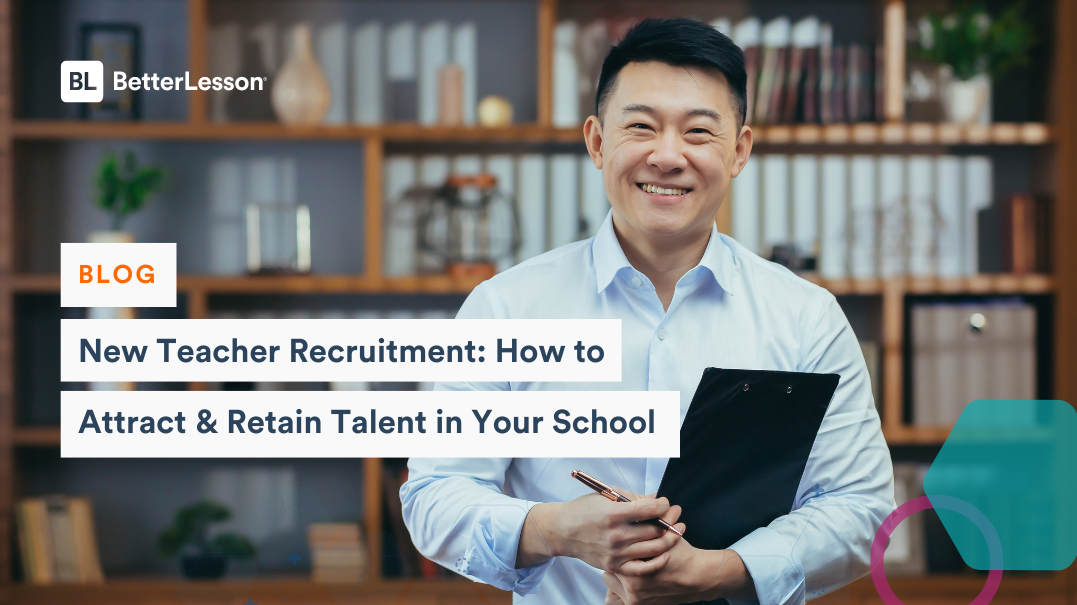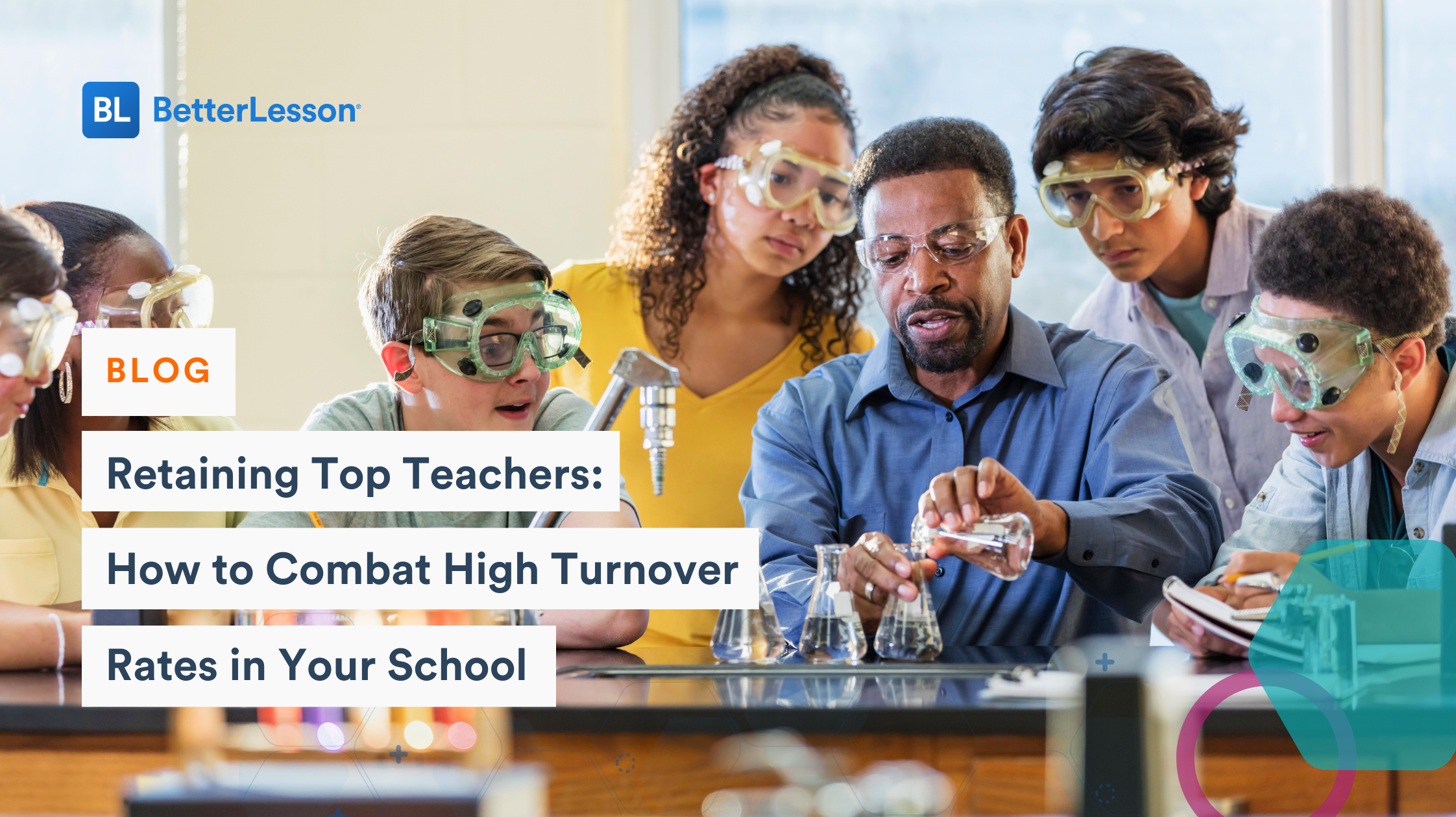Struggling to attract and retain top talent in your school or district? Last year, BetterLesson hosted an engaging and interactive webinar on Innovating Recruitment Strategies for K-12 Principals and we’re here to breakdown the key takeaways for you.
Recruiting effective teachers is one of the most impactful strategies for accelerating student learning, but it can also be one of the most challenging tasks for principals. Not only do they need to actively seek out new talent, but they also need to onboard, mentor, and support their educators to ensure they reach their full potential. How can Principals and district leaders develop the vision and intention they need to bring in top-quality staff and create a rigorous school program that produces better educational outcomes for students?
In this blog post, we will share innovative strategies to attract and retain high-quality teachers who will help your school thrive.
Context: Causes and Factors that Impact Educator Retention
There are several factors that contribute to educator retention, some more local and context-specific and others more common across contexts. Broadly speaking, wellbeing and burnout are two pervasive factors that impact teacher retention.
In fact, recent survey data by RAND Corporation reveals, compared to other professions, teachers and principals report worse levels of well-being; 85% of school principals and 73% of teachers report job-related stress. Even further, the data suggests that poor well-being and stressful working conditions are associated with teachers’ and principals’ intention to leave their positions. Conversely, there is a clear connection between more supportive school environments and a decreased likelihood of intentions for teachers to leave their positions. Since the pandemic and the increased stress it brought, teachers and principals also report a desire to focus on core job responsibilities and foster positive colleague relationships.
We also know that there is a lot at stake when it comes to teacher retention. Developing high-quality education systems requires a consistent base of educators. Attracting and retaining experienced and effective teachers can lead to better outcomes for students, cost savings for schools and districts, and ongoing professional development opportunities for educators.
What Can Leaders Do?
Recruiting and retaining high-quality educators requires a strategic, ongoing, and proactive approach. We are going to offer a framework for innovative recruitment and retention strategies with actionable steps along the way. The framework is built around the “Three A’s”: Acquisition, Acceleration, and Assessment.

Acquisition:
Like it sounds, this component is focused on acquiring or recruiting high-quality educators. There are several tangible strategies principals and district leaders can implement to improve their acquisition efforts.
- Forecast vacancies: Principals and school leaders should keep track of teachers who intend to transfer, take an extended leave of absence, or even resign. Having systems in place (i.e. anonymous surveys) to monitor future vacancies can allow schools and districts to be proactive in their recruitment efforts.
- Recruit continuously: Vacancies are inevitable. Rather than waiting for vacancies to occur, school leaders can create a pool of potential hires, including student-teachers, retirees, strong teacher assistants, substitute teachers, and “boomerang teachers” (teachers who left the profession but have interest in returning).
- Hire early: There is a direct correlation between teachers being hired at an early date and eventually showing high-quality performance. There is also a relationship between early-hires and increased student achievement. Hosting annual career fairs can be one proactive and systematized approach to hiring early.
- Create efficient hiring processes: If a school’s hiring process takes too long, a teacher candidate can end up accepting an offer elsewhere before even having the opportunity to respond to an offer from another school. To avoid this, principals and school leaders should work with the district to develop efficient and timely hiring processes and procedures.
- Utilize effective interviewing strategies: Interviews are key to hiring high-quality talent. One impactful interviewing strategy is to incorporate Behavioral Interview Questions. Rather than asking generalized or hypothetical questions, Behavioral Interview Questions ask about candidates’ lived experiences. This allows the interviewing committee to understand more tangibly whether a teacher candidate is an appropriate fit. Another effective interviewing protocol is to create a well rounded interview committee that includes not only administrators, but educators, school staff, and perhaps even parents.
- Create a compelling school environment: At the individual school-level, principals often have little-to-no say on teacher salaries. This can be a challenge to recruitment efforts if nearby districts offer higher salaries. While this can give principals the illusion of a lack of agency, it’s important to recognize that there are important factors that can off-set differences in salary. Since we know teacher wellbeing is tied to retention, creating teacher schedules that allow for more prep time, more collaboration, and more opportunities for professional development can sometimes carry more weight than higher salaries.
If you are looking to dig deeper into teacher recruitment, check out this blog on teacher attraction and retention.
Acceleration:
In tandem with ongoing acquisition efforts, principals and school leaders need to be strategic about where to assign new team members, how to onboard them into their new roles, and which school staff will make the best mentors to help each new hire feel supported and reach their potential. Here are some strategies to support with onboarding and supporting new hires:
- New teacher orientation: Planning a new teacher orientation at the start of the school year not only sets a welcoming and supportive tone, but it allows new teachers opportunities to meet colleagues, increasing their access to support and collaboration. Teacher leaders can even facilitate parts of the new teacher orientation to jumpstart those professional relationships.
- Provide new teacher support: Ensure you have a new teacher academy/program in your school/district that includes at least a 90-day onboarding experience. Having a spread out onboarding plan ensures that new hires aren’t overwhelmed with information right now; rather, a 90-day onboard plan allows information and support to be scaffolded. To make such a comprehensive onboarding experience more sustainable, consider leveraging your strongest current teachers to help lead this initiative.
- Prioritize mentorship: Assign all novice educators a mentor for at least their first three years. Ideally, the mentor and the new teacher should share the same licensure area and job assignment for easier and more aligned collaboration.
If you want to learn more about strategies to retain and support new teachers, check out our comprehensive Guide to Teachership: How to Support Our New Teachers.
Assessment:
Along with ongoing recruitment and retention efforts, school leaders should also continuously monitor and assess the strengths, needs, and opportunities among their current teaching staff. Here are some ways to engage in this type of teacher assessment:
- Identify successors for key positions: Continuously develop and prime educators for promotions and other vacancies as needed. Promoting from within a district (when possible) keeps high-quality talent within the district. Many teachers also crave opportunities for leadership and career advancement, so when those ambitions align with a school’s needs, everyone wins!
- Create Tiers of Support: Just like teachers continually monitor student progress, principals and school leaders should monitor their teachers progress and needs for support. By creating a clearly outlined tiered support plan (i.e. Tier 1: minimal support needed; Tier 2: some support needed; Tier 3: significant support needed) through monitoring systems like learning walks and teacher surveys, principals and school leaders can be proactive in their approach to supporting teachers.
If you’re interested in understanding the critical role of teacher leadership, read this blog on the importance of leadership career ladders for teachers.
Comprehensive Professional Development
One key component to teacher recruitment, retention, and growth is effective professional development plans. School leaders should adopt an on-going support model for educators that includes touch-points throughout the year and different learning experiences. At BetterLesson, we have developed an ecosystem of connected learning experiences that can support the three phases of teacher recruitment and retention.
In the Acceleration phase, for example, principals might focus on providing high-quality virtual or in-person workshops, one-to-one coaching, asynchronous resources, such as on-demand courses, lesson plans, and instructional strategies. To support the Assessment phase of teacher retention, principals can include classroom observation learning walks to gauge teaching and learning.

It’s important to note that principals, too, require ongoing professional support in order to effectively lead and support their own teaching staff. BetterLesson offers year-long PD programs that can support new teachers and principals alike, to ensure success at all levels of the school environment, from leadership to classroom instruction.
Often the biggest barrier to developing and implementing impactful teacher recruitment and retention plans is a lack of capacity. Schedule a call with us today to learn more about how we can partner with your school or district to improve teacher retention and support through personalized professional development plans.
Get in Touch







